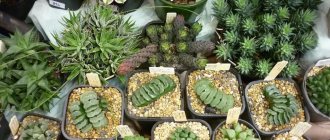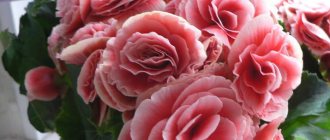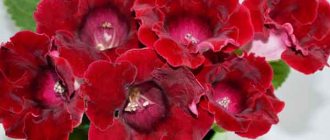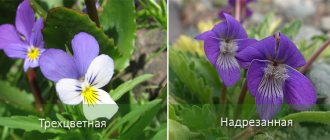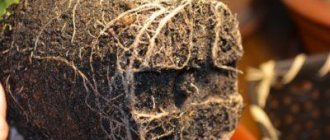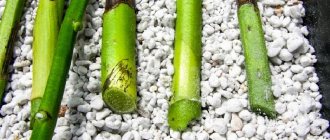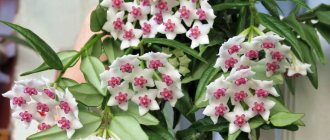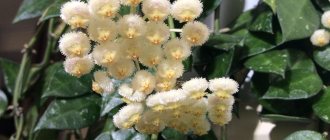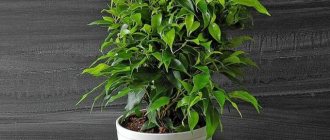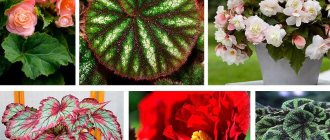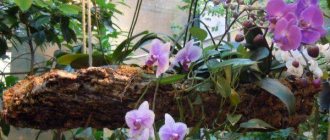Reproduction
Griffin, like any other Royal Begonia hybrid, reproduces vegetatively: by leaf cuttings or by dividing the rhizome.
Rooting a leaf fragment
A large leaf blade is divided into segments so that each has a thick vein. She is the one who will give the baby. Loose soil is used for planting. It is watered in advance and poured into a transparent glass. The leaf is planted and placed in a greenhouse.
As soon as a new sprout appears, the glass is taken out of the greenhouse and the flower is grown as an ordinary houseplant.
Transfer
Griffin is not afraid of transplantation. If rejuvenation of the flower is necessary, the lower leaves are torn off, part of the root system is cut off and the rhizome is deepened by several centimeters. Each next pot needs to be chosen a little more by 1.5 centimeters.
Begonia is a plant that has won the hearts of many gardeners. The Griffin is one of the last crossed hybrids. It is most suitable for growing at home because it is less demanding in its environment.
If you find an error, please select a piece of text and press Ctrl+Enter.
Royal begonia, or Rex begonia, is deservedly one of the most popular decorative deciduous species. She received this royal name for her rich and sophisticated appearance.
The brightness of the leaves, the variety of their shapes and colors, compactness and relative ease of care make the plant an increasingly welcome guest in many homes and offices.
Popularly, royal begonia is sometimes called “elephant’s ear” due to the similarity of the shape of the leaves with the ears of this animal.
Which plant variety to choose? How to properly care for and propagate it? What features are important to consider?
Botanical description and history
Compared to the Royal one, Griffon begonia is characterized by larger leaves, which are shaped like a griffin's paw . The height of the plant reaches 40 cm. The leaf blades are dissected with an unusual black-green tint and a silver pattern.
The royal begonia was first discovered at auction in 1856. In 1959, the first three hybrids were bred. Since then, work has been actively carried out to grow new varieties of crops. Begonia of different species was used for crossing:
- Chinese.
- Yellow.
- Powerful.
Over the entire history of breeding Royal begonia, a wide variety of varieties have been crossed, differing in leaf shape and color. The last of the hybrids is the Griffin begonia. The culture is less demanding, so it is grown at home as a perennial, and as an annual in the garden.
Diseases and pests
Goji planting and care in open ground: how to grow healthy berries with your own hands.
growing tips (video and 85 photos) Most often, ever-flowering begonia becomes a target for attacks by aphids and spider mites. If the plant is indoors and does not grow in a flower bed, then it is better to treat it using organic products. For example, the bush can be sprayed with an infusion of onion peels or finely chopped turnips. Pest control is carried out once a week until signs of damage completely disappear.
The disease from which begonia suffers is easier to determine by the condition of the bush itself. For example, if black spots begin to appear on the leaves, then we are talking about bacterial wilt. On the contrary, the appearance of a white coating on the surface signals an infection with powdery mildew. In both cases, fungicides, such as Mikosan, will help cope with the problem. Unfortunately, the begonia will have to be thrown away if it becomes ill with viral mosaic, which is determined by the appearance of yellowness on the tips of the leaves, root rot and nematodes.
For information on the propagation and preservation of everflowering begonia, see the video below.
Caring for begonia in a pot at home
- What to do if a plant's leaves curl up?
Aggressor cabbage: useful growing tips
When the leaves of the plant's lower tier dry out and curl up, they are old and already dying off.
If the leaves become a dark shade throughout the flower, then you should pay attention to this
Begonia should be watered evenly: the soil should not be too wet, but do not allow it to dry out. Leaves can also curl if there is a lack of nutrition, then the flower needs fertilizer.
- Spraying.
Begonias like moisture, but not too much. If the leaves of the plant are smooth, they can be sprayed. “Fluffy” leaves are not sprayed, and the air is humidified only around the flower.
- Location of begonia.
The flower can be placed on a window facing southeast and southwest.
- When spots or holes appear on the leaves.
Spots occur if you water the plant with cool or hard water. There are holes left on the leaves - drops of water caught in the sun's rays can cause burns on the flower.
- Begonias with double leaves have smooth flowers.
Begonia flowers produce female (pistil) and male (stamen) varieties of flowers, and they bloom at different times. Female smooth flowers can be plucked so that the double color is more abundant.
- The appearance of the first flowers.
The first flowers develop when there are 5-6 knees on the stem. Until this time, the houseplant rarely blooms.
- If the flowers darken and fall off.
This occurs when water gets on the flowers.
- Powdery spots appeared on the leaves.
If gray mold or powdery mildew occurs, the damaged leaves are removed, the flower is sprayed with a fungicide, and the room is ventilated.
- For what reason do flowers and leaves fall off?
This happens when water gets on the begonia, or there is not enough moisture, or the air in the room is not humid enough.
- Harmful insects.
Begonia is afraid of spider mites and aphids.
- Begonia transplant.
The plant is replanted in the spring.
- The soil.
Soil: turf, coniferous, leaf soil, river sand, peat.
- The buds are falling.
This may be a deficiency, as well as an excess of moisture in the soil, a draft, moving the pot in relation to the sun, and even more so if the plant has been moved to another room.
- The plant does not bloom.
Reasons: lack of light, dry air, heat or cold, draft, excess fertilizer.
If the plant withers, you need to root the branch.
What causes royal begonia:
- Gray rot.
The disease is caused by the fungus botrytis. It is able to multiply in warmth and moisture, and white spots with a grayish coating appear on flowers and leaves, and subsequently rot. As a result, the stem becomes brittle, the leaves darken, curl, and a mucus coating appears on the inflorescences and buds. For initial symptoms of gray rot, the flower should be sprayed with 1% Bordeaux mixture or a solution prepared from 20 grams of laundry soap, 2 grams of copper sulfate and one liter of water. If the disease spreads, the plant must be treated with 1% foundationazole.
- Bacterial spotting.
With this disease, begonias develop small glassy watery spots on the back of the leaf. There is no way to get rid of the disease, therefore, damaged leaves must be removed, and the soil in which the plant grew should be disinfected. As a preventive measure, the flower must be treated with a 5% suspension of copper oxychloride twice every 14 days.
- Ring spot.
The disease is caused by a tomato virus. At the same time, green-yellow furrows appear on the begonia leaves, which over time turn into bronze-colored spots and necrosis. The damaged plant must be eliminated; as a preventive measure, thrips, aphids and other insects that spread the viral disease should not be allowed to appear on the flowers. In addition, weeds should be removed promptly.
Royal begonia video
https://youtube.com/watch?v=mzAm6M2nvJA
Royal begonia photo caring for a flower at home is not that difficult, follow the recommendations of the site farmer without hassle and you will not have any problems with it.
Royal begonia - care:
Lighting:
How to grow a date palm from a seed at home? tips and tricks for proper cultivation
Royal begonia loves saturated diffused light or can be in partial shade. Open or direct rays of the sun are destructive for Royal Begonia.
Temperature:
The heat-loving beauty Royal Begonia does not like excessive temperature changes. The optimal temperature for Royal Begonia is about 16°C - 25°C, in winter not lower than 12°C -15°C.
Watering:
Royal begonia does not tolerate stagnant moisture in a pot, because the root system can rot. Also, Royal Begonia cannot withstand dry soil. Royal Begonia should be watered moderately, and most importantly, systematically. Royal Begonia should be watered with lukewarm, settled water, preferably slightly acidified. In the autumn-spring period, Royal Begonia is watered much less.
Humidity:
Royal begonia loves a damp atmosphere, but cannot tolerate water getting on its leaves. It is advisable to place the royal begonia on a tray with expanded clay or wet pebbles.
Feeding:
The soil used for Royal Begonia is nutritious - consisting of humus, leaf, turf soil to which a little river sand and coniferous soil are added. Royal begonia loves soil with normal acidity.
Transfer:
It would be good to replant royal begonia in the spring, every year. In a small pot, the leaves of Royal Begonia lose their decorative effect and gradually fade. After replanting the royal Begonia, you need to cut it off.
Reproduction:
The most popular method of propagating Royal Begonia is from stem cuttings. Royal Begonia also multiplies without difficulty by leaves, (part of leaves), by dividing bushes and by seeds. The stems of Royal Begonia are divided into parts 3 cm long and pressed well into the soil for rooting in pots; it would be good to heat the soil from below.
Some features:
On the pedicels of Begonia regal there are both female and male flowers. In female flowers of Begonia regal, a triangular seed box will form above the petals.
Care
Caring for royal begonia at home is not that difficult. The main thing is to know some of the nuances of watering and fertilizing, as well as selecting a suitable place to place the plant. Begonias are quite light-loving plants, and this is precisely why they have such a juicy and bright color of their leaves. Therefore, it is not recommended to place them in too dark areas of the living room. If there is a lack of light at any time of the year, the leaves of the plant may turn pale and even begin to dry out. It is recommended to avoid direct sunlight. Begonia leaves are quite delicate; direct exposure to UV rays can cause burns. In general, the ideal place to place a houseplant is in partial shade with sufficient incident light.
Royal begonia is tropical and therefore very heat-loving. The ideal temperature regime for its comfortable growth ranges from +15 to +25 degrees. Temperatures above 30 degrees and constant drafts are undesirable for her. In the summer, pots with begonias can be taken out into the fresh air, but not under the open scorching sun. In winter, begonia can feel great in closed loggias, where the temperature fluctuates around +16-17 degrees.
It is very important to water the plant correctly and under no circumstances overwater or flood it, otherwise excess moisture can lead to serious diseases and loss of leaves. In summer, watering should be plentiful; the soil should not be allowed to dry out.
As a rule, in the warm season it can vary from 2 to 4 times a week depending on the age of the plant and the container in which it grows. Watering should be done with water at room temperature, preferably settled. Excessive moistening of begonias using a spray bottle is not recommended. This procedure can be carried out, but not very often.
The velvet leaves of royal begonia very often collect dust from the air, thereby cleaning the room, so it is recommended to wipe them with a damp sponge or a soft cloth about once every 2-3 weeks as they become dirty
When performing any actions with the plant, including watering and cleaning, it is very important to remember that it is very fragile, so any manipulations should be done as carefully and carefully as possible
To improve the quality of life of the plant, it is recommended to feed it. You can do this once a month or less, but not more often. It is best to purchase ready-made fertilizers in specialized stores. As preventive measures against diseases and pests, you can use herbal infusions, which not only do not harm the life of the plant, but also serve as a kind of natural nutrition.
Characteristic
Begonia Griffin comes from one of the most popular species of this plant - the Royal Begonia. This Queen Mother gave rise to most of the flower's hybrids .
History of origin
For the first time, the Royal Begonia was discovered at an auction in London in 1856 among Asian orchids. And in 1859, the first three hybrids were already bred. After this, active work began on growing new varieties and varieties of this plant. The material for crossing was mainly yellow, Chinese and powerful begonias.
Over the entire period of the history of breeding the Royal Begonia, their numerous varieties have been crossed, which differ in color and leaf shape. The last of these hybrids is the Griffin. It is more versatile for growing at home because it is less demanding.
External features of the flower
Begonia Griffon is a strong and durable decorative leafy flower that attracts great attention as a perennial crop - at home in a pot, and as an annual - in the garden.
The name of this plant comes from its structure: lush large leaves in shape resemble the open paw of a griffin, black-green in color with a silver pattern. This culture will bring comfort to your apartment. Against the background of dark begonia leaves, bright green plants will sparkle with new colors.
The griffin can grow up to 41 centimeters in height. Experienced gardeners recommend breeding this type of begonia in a container culture, taking it out into the garden in the summer and putting it away in the house in the winter.
IMPORTANT! This type of begonia is stress-resistant to external adverse conditions. It is not demanding on watering and soil, and is also much simpler to use in agricultural technology, compared to other hybrids.
Home care for Royal Begonia
Begonia does not require special conditions, but to maintain its bright colors, it is necessary to create certain conditions.
Landing
The first planting of the plant after successful cultivation from seed occurs in the fourth week. When planting, you should follow the recommendations for the composition of the soil and the type of pot.
Priming
For rex begonia, nutritious soils with medium acidity are preferred. In specialized stores you can buy ready-made soil for begonias. To prepare the soil yourself, you will need to mix the following components: peat - 1 part, sand - part, leaf soil - 2 parts, humus - 2 parts.
Choosing a pot
There are some requirements for the container for planting royal begonia. The pot must be wide for the characteristic development of the root system, contain drainage holes and a tray. The height of the pot is not critical, since the roots do not go very deep.
Watering
Watering should be done moderately and regularly. The earthen ball should not be overdried; the soil needs to be slightly moistened. But excess moisture contributes to the deterioration of fleshy stems and roots, so stagnation of water in the pot should not be allowed. When watering, it is recommended to avoid getting moisture on the leaves, which can lead to rotting of the leaves. Watering is carried out with filtered or settled water at room temperature.
Light mode
Royal begonia requires good lighting with indirect sunlight. Direct sunlight is undesirable for leaves. Window sills oriented to the east or west are suitable.
Trimming
At the beginning of the flowering period, it is recommended to trim the flower stalks, as they lead to depletion of the plant and deterioration in the appearance of the leaves.
At the end of winter - beginning of spring, a period of active growth approaches, which should be prepared by pinching the rhizome and reorienting the young parts of the root towards the center of the pot. Thanks to the actions taken, the growth of new shoots on the thinned rhizome and the formation of lush bushiness are resumed.
It is advisable to cut an old plant to restore its attractive appearance.
Thermal mode
The optimal temperature for the good development of royal begonia ranges from 17 to 25 degrees Celsius.
In summer, begonia reacts poorly to heat, and in winter it does not tolerate air overheated by heating devices.
Begonia grows well all year round, slightly slowing down its development during the onset of cold weather. In this regard, creating a rest period with a reduced temperature is not required.
Growing at home
Begonia Griffin, like other plants, requires attention and care. She needs timely watering and feeding. She loves the sun, especially during flowering, and high air humidity. This is explained by the fact that begonia originally grew in the tropics.
In general, caring for begonia is not difficult . The most important thing to remember is a few basic rules for care: maintaining optimal temperature, good lighting, which will help the flower bloom its lush flowers.
Basic rules and methods of planting
Any types and forms of begonias are planted either as tubers or seeds (read about tuberous begonias here). The most popular method is planting with tubers, as it is less labor-intensive but effective.
With this type of planting, it is necessary to remove the tubers from the ground, thoroughly clean and trim the stems. After this, the treated tubers are stored all winter in peat, and the storage temperature should be maintained at +8 - +10 degrees. The period of planting tubers in the ground lasts from February to May.
Tuber germination occurs in small pots filled with sandy soil. It is important to remember that the tubers are only immersed halfway into the ground. At this time they require moderate watering. After a couple of weeks, the tubers germinate, roots and shoots appear. As soon as they completely germinate, the tubers should be sprinkled with soil and the pot should be placed in a well-lit place.
Planting begonias with seeds is a more complex process that requires due attention, since for seeds it is necessary to prepare a soil mixture of leaf soil, sand and peat in advance. Seeds can also be germinated in peat.
Since begonia seeds are small enough, there is no need to bury them in the ground. Experienced gardeners carefully sow them on the ground and press them down a little with their fingers. After two weeks they germinate.
ATTENTION! It is necessary to replant a grown begonia into a pot with a lump of earth!
The third planting method, cuttings, also has its own nuances. To create a leaf cutting, you need to take a leaf about 5 centimeters long, but no less. This cutting is buried in such a way that the leaf does not touch the ground . The soil around is crushed and watered.
Lighting and location
The plant loves a lot of diffused light. This is due to the fact that under natural conditions it belongs to the lower row of flora, which is covered by tree crowns.
Griffins do not like direct sunlight. With one such hit, the rich color of the leaves begins to fade and the foliage begins to dry out.
At home, it is better to place flowerpots with flowers on shelves or a table opposite a light source, and create a small shadow using curtains. It is better to exclude window sills from the list of favorable places for begonias .
In tropical climates, where begonias are accustomed to growing, the sun is always at its zenith, so plants have not learned to turn towards the light as in temperate latitudes. Based on this, flower growers do not recommend moving flower pots from one place to another.
The soil
Special requirements for soil are explained by the structure of the root system. Since the begonia rhizome is located on the surface from which thin fibrous roots extend, the substrate must be chosen to be breathable. This will help the plant receive more moisture and nutrition.
An excellent option would be a peat-based soil mixture . It has a favorable low acidity for Griffin. Humus, leaf soil or baking powder can be added to peat in a ratio of 1:3.
Care
Caring for begonias at home is quite simple.
- Begonia Rex loves warmth. The ideal temperature for her is plus twenty-five. But the heat (even around plus thirty) definitely won’t do her any good. But the plant is not friendly with cold either. The lowest temperature at which it can survive the winter is plus fifteen. Of course, preparations for frost need to start in advance. If you are used to keeping the plant outside or on the balcony in the summer, then at the end of August you should return it indoors.
- Begonias, of course, need sunlight to grow. But direct exposure to rays is allowed only in the morning and evening, when they are not so bright. The flower should be hidden from the midday sun in the shade, but it is even better to place the pot on the windowsill in the northern part of the house. And if the light hits only part of the plant, its shape will be distorted and it will lean to one side.
- Watering is perhaps the most difficult part of caring for begonias. It needs to be watered in moderation. The soil should dry out completely between waterings. At the same time, its overdrying is dangerous for the plant. But waterlogged soil is even more dangerous. Use soft water (boil it before watering). Also make sure that the liquid does not get on the leaves.
- It would be useful to use fertilizers. The plant requires them in spring and summer. If you have not found a special fertilizer for this variety, you can use any fertilizer for decorative deciduous flowers. Just carefully study the composition - fertilizers that contain too much nitrogen are not suitable for begonias.
Home care
Lighting
In light mode, it is better to follow the golden mean and place the plant on windows facing southwest or southeast. In this case, the light should be diffused. Begonia loves light, but direct sunlight causes burns on the leaves.
Temperature
The plant is thermophilic; the room should not be colder than 18° C. Tiger Begonia does not bloom very beautifully, but those who still want to see it bloom must ensure sufficient air temperature.
Watering and fertilizing
For irrigation, only soft water at room temperature is used. Do not allow water to get on the leaves when watering or spray the plant - this will lead to the appearance of unnatural spots.
In the warm season, water as the soil in the flowerpot dries. Excess moisture leads to rotting. At the same time, you need to feed with complex fertilizers. In winter, the plant rests and does not need feeding. Watering should be reduced to a minimum.
Begonia does not like rich feeding. It is better to make the concentration of nutrients less than indicated in the instructions for the fertilizer and feed no more than once a month.
Humidity
Begonia cannot be sprayed, but it loves high humidity. To moisten, place a tray filled with raw moss under the flowerpot. A container of water or wet expanded clay placed next to the plant will also provide the begonia with sufficient moisture.
Reproduction, soil and planting
Tiger begonia propagates from cuttings and rhizome particles. You can take the top of a shoot as a cutting, but a single leaf with a leaf cutting of at least 5 cm is also suitable. Ingredients of the soil for planting:
- peat;
- perlite;
- coarse sand;
- humus.
Everything needs to be taken in equal parts, mixed and placed in a small pot. The leaf stalk is buried halfway into the soil. You can take a larger pot, then it will be possible to plant several cuttings at once.
Begonias have creeping rhizomes, and the bush grows wide, so flowerpots for them are better suited to be wide, but not tall.
At first, the seedlings need to create greenhouse conditions, for which you need to put a bag with ventilation holes on the pot. The room temperature should be from 17° C. If several cuttings were planted, then after 2 months they need to be planted in separate pots.
Only a well-rooted plant is suitable for propagation by roots. You need to separate part of the root and transplant it into a separate pot. Place the bag on top, as in the version with cuttings. Begonias reproduce well with either of the two options.
Replanting and pruning
Tiger begonia needs to be replanted at least once every 2 years, otherwise the plant loses its decorative qualities. Each time a larger pot is selected. Flower growers consider clay to be the best material for a flowerpot.
In order to ensure successful rooting, the leaves are cut off when transplanting. Immediately after transplantation, the plant is placed in the shade for several days. The young plant is replanted every spring (up to 4 years).
The flowerpot cannot be filled to the top with soil, since the roots of the plant constantly crawl to the top and need constant sprinkling. There should be some space left for this powder.
Photo
Next you will see a photo of how to care for tiger or bauer begonia:
You may find useful information about decorative deciduous varieties of begonia and how to care for them, as well as about varieties such as Red-leaved, Masona, Hogweed, Cleopatra, Royal, Spotted, and Collared.
Photo
You will see a photo of the plant:
If you like begonia and are thinking about growing it, then first you should study the varieties and types of this beautiful plant, as well as learn about the features of care and propagation. We will help you with this. Read about the following varieties: Metallic, Royal, Griffith, Hogweed, Imperial. It will also be interesting to get acquainted with decorative deciduous begonia.
What you didn't know about this plant...
- It is not perennial. Indoor Rexes live for 2, maximum 3 years. In order not to lose the flower, you need to cut the stalk from it in time - and you will always have these decorative leaves growing.
- Rex is a modern hybrid. This explains the unpretentiousness of decorative foliage.
- This plant comes from India, namely from the state of Assam. Doesn't it remind you of the name of a popular tea?
- Royal begonia is popularly called “elephant ears” or “Napoleon’s ear” (as it is believed that at the beginning of the 19th century this commander froze one of his ears in a harsh winter while retreating from the territory of the Russian Empire).
By the way, there are actually a lot of types of begonias. While some have simply beautiful leaves, others bloom so much that the roses will wither with envy.
This colorful video will introduce you to all the diversity of the world of begonias:
Diseases and pests
When growing this flower, you may encounter various diseases, insect attacks and other problems. The most common diseases are as follows.
- Gray rot. Its cause is often increased air temperature and excessive humidity. Characteristic signs are whitish spots on the foliage, resembling a coating that gradually covers the entire surface. These signs cannot be left without attention and medical procedures, otherwise the flower will die.
- Bacterial spotting. Characteristic signs of the disease are small, watery spots that form on the leaves. Unfortunately, this disease cannot be cured. If the plant suffers such trouble, it is necessary to throw it away and pour out the old soil. The container in which it was located is thoroughly washed.
Among the insects that often attack begonia, experts name spider mites and scale insects. Here are some other problems that can plague begonia during development, and how to deal with them:
- dropping leaves in winter means hypothermia of the flower; it is necessary to increase the temperature in the room if the leaves fall en masse;
- discoloration of the leaves before discarding indicates damage by a nematode, which cannot be cured, so the plant and soil will have to be disposed of;
- lethargy of foliage indicates that “Coralline” is exposed to harmful substances, such as gas or tobacco.
Perhaps the most common problem for gardeners growing begonias is the lack of flowering. The problem has a number of reasons:
- immaturity is a natural cause that disappears as soon as the plant matures to the required age and gains strength;
- improper lighting, or rather, its lack, this problem can be easily solved - move the flower to the light;
- dry air, as a rule, in addition to colorlessness, drying edges of foliage are also observed; increasing the level of humidity in the room (humidifier, bowls of water) will help correct the situation;
- cold does not contribute in any way to the formation of beautiful inflorescences, so monitor the temperature in the room;
- an erroneous dormant period leads to weakening of the plant, it does not have enough energy for flowering, it is necessary to restore the schedule by moving the flower into the shade for the summer, reducing daylight hours, reducing moisture, then slowly restoring the state of the begonia;
- a lack of microelements also has a negative effect on flowering; replanting into high-quality soil specialized for this type of plant will help;
- pests and diseases do not contribute to healthy flowering, it is necessary to treat “Coralline” if possible.
See below for cuttings from coral begonia.
Useful properties of Begonia Griffin
Begonia Griffin, like its relatives, is endowed with many useful qualities. It is recommended to have such a flower at home for people who often smoke and suffer from chronic bronchitis or chest pain.
Due to the flower’s ability to fight streptococci, traditional healers consider it a good idea to place begonia in hospital compartments and the rooms of elderly people to increase their vital activity.
Begonia planted in the home has a beneficial effect on the immune system, relieving fatigue and nervousness, and increasing brain activity. For this reason, traditional medicine also recommends it as an office flower.
Traditional healers attribute painkillers with an anti-inflammatory effect to begonia; it has antispasmodic and antiallergic characteristics.
Tincture of begonia flowers is used to treat various wounds, ulcers, burns and rashes. The juice of the leaves relieves headaches - just chew the leaf. Decoctions are prepared from the roots to treat conjunctivitis.
Interesting Facts
- Begonia has won the hearts of many gardeners so much that an asteroid discovered in 1920 was named after it.
- According to Chinese legend, begonia first sprouted from the fallen tears of a girl in love.
- At the Belgian Flower Festival, florists and designers use begonia flowers and leaves for their floral arrangements.
- In the Himalayas, culture is a seasoning in the preparation of national dishes.
- Begonia living in the house will reduce the content of staphylococcus in the air by 80%.
Kinds
Depending on the variety, terry begonia can differ in the structure of the root system into the following types:
tuberous - more suitable for planting at home;
There are varieties with an ampelous type of plant and a regular one. The ampelous variety is more suitable for planting on a hedge or at home, since it will take up less space. If we take as a basis the classification of terry begonia by the famous specialist in the field of ornamental gardening V.V. Vorontsov, we can distinguish the following main varieties of the plant:
- deciduous decorative;
- bush;
- tuberous;
- beautifully flowering.
Deciduous begonias are common varieties and are most often used to fill empty areas of the garden, and they are also often planted in pots to decorate the windowsill and refresh a private city apartment with greenery. Terry begonias are the most common among the last three varieties. It is worth taking a closer look at the most popular varieties.
"Dreamland"
This is a very common variety, preferred by many experienced flower garden owners. It is distinguished by beautiful neat buds, which in their structure resemble camellia flowers. Thanks to the light terry on the edges, they look airy and very feminine. Flowers of this variety are an excellent option for decorating a site, therefore they are most often used by landscape designers in their projects. Begonia is ever-flowering, planting is carried out by cuttings. Maintenance is quite simple and does not require much effort. The color of the bud can be any. The most common plants of this variety are those with white or pink flowers.
"Fiona"
This variety is distinguished by very delicate translucent buds. Together with terry, they create an interesting impression. This variety is perfect for decorating a garden and summer cottage, and will also attract the admiring glances of guests. The color of the bud is bright and does not fade. They usually have a rich pink or light orange hue. The leaves are dark green, smooth, quite large, and in combination with flowers they look very impressive.
"Queen"
This is a perennial shrub. It is the most suitable option for planting in large vases and flower beds. The flower is neat and small, also suitable for growing indoors. The buds are half-opened and resemble rose flowers in appearance. They look extremely attractive and are actively used to create a romantic mood. They are often used by designers to create the right atmosphere for large celebrations. "Queen" is represented by several subspecies, which can be of three colors - white, red or orange.
"Yellow"
This variety will help create a bright accent on the site due to its large buds of rich yellow color. The terry edges give them a special charm, thanks to which the plant is very popular among many summer residents. The leaves of “Yellow” have a neat appearance and are distinguished by a dark green color, which harmonizes perfectly with the color of the bud. Most often, this variety is grown in spacious pots that decorate the site.
"Fire Coral F1"
In search of an unusual flower, experienced landscape designers recommend paying attention to the densely double annual variety “Fire Coral F1”. Its bud is distinguished by its bright fiery color, which shimmers from light to rich orange.
Thanks to the large amount of terry, the flower looks more impressive and really gives the impression of a flower engulfed in fire.
Most varieties of terry begonia are excellent for growing not only in open ground, but also at home. Indoor begonia is unpretentious and quite easy to care for - you just need to create the necessary conditions for its growth and development.
Appearance and features
The large lush leaves of the Griffin have a special beauty - they are shaped like palm trees. This durable and strong ornamental flower attracts attention for growing in pots. The hybrid is a bushy herbaceous plant with a creeping thick stem and leaves with pronounced carved edges.
Features of begonia Griffin:
- Suitable for placement in a conservatory to create an accent.
- Ideal for creating flower arrangements in combination with other varieties of begonias.
- Throughout the year it has a decorative appearance.
- In open ground it is unpretentious to weather conditions.
Reference. Griffin, unlike other Royal Begonia hybrids, is much simpler in agricultural technology.
Reproduction
Like all other hanging begonias, Sutherland begonia reproduces well by cuttings. Apical cuttings can be rooted even just in water. But if desired, rooting can be carried out immediately in small growing pots, in loose universal soil (both under a cover and without). It is cuttings that are used as a method of renewing plants that have lost their decorative value and need rejuvenation: the tops of the branches are cut off, re-rooted, replacing old bushes with new plants.
We invite you to familiarize yourself with Carrots for weight loss: benefits and harms, in what form you can eat them, features of the carrot diet, reviews
Begonia can also be grown from seeds. Sowing is carried out according to the rules common to all garden and indoor begonias - in early spring, in a loose substrate, under glass or film.
Begonia seeds are sown in December-January. They are sown superficially in a 2:1:1 mixture of leaf soil, non-acidic peat and sand. The crops are covered with glass and regularly moistened from a tray with water heated to 30°C.
Begonia: briefly about the flower
Begonia belongs to the Begoniaceae family, and this flower is named after Michel Begon, who back in the 17th century first made a complete description of this flower growing in the Antilles. Despite the fact that today many species and varieties have been bred, including frost-resistant ones, the most optimal climate for begonia is the weather of the tropics and subtropics.
Blooming begonia is a wonderful decoration for a garden, terrace or room in an apartment. With proper care, this flower will regularly show beautiful blooms.
Shrub species of begonias are grown in open areas of gardens and household plots. Decorative flowering and decorative deciduous varieties can be equally successfully grown at home, there or in the open ground. With the help of their beautiful, whimsical colors and shapes, landscape designers design flower beds and flower beds.
The beauty, tenderness and originality of begonia is the main reason for the popularity and wide distribution of the flower.
At home, blooming begonia invariably decorates the room in which it grows. Its flowering period begins in July-August and can last until December. Most plant varieties have large voluminous buds of various colors. This is why they are valued by amateur flower growers who grow them at home.
Landing
In pots
Griffins love diffused light. They need to be protected from direct sunlight so that the leaves do not get burned. The windows are darkened with tulle curtains.
Planting material is purchased in winter and stored in a cold place until spring. The planting period is from March to May. To plant the crop, use a substrate for indoor plants. You can prepare the soil composition yourself. To do this, mix one part at a time:
- River sand.
- Peat.
- Leafy soil.
- Derna.
Important! Begonias do not tolerate acidic soil. The soil should be light, fertile, with good breathability.
To plant the Griffin, you can use a ceramic, plastic or any other pot. The dishes should not be very deep and spacious in width. To allow excess moisture to drain into the pan, drainage holes are made at the bottom of the pot and on the sides.
Royal begonia hybrids are planted either from seeds or tubers. The last option is preferable.
Planting technology:
- The bottom of the pot is drained: expanded clay and pebbles are laid.
- River sand is poured over the drainage.
- Add substrate.
- Moisten the soil and plant a flower.
The plant is not completely buried. To prevent the root collar from rotting, it is left on the surface. After two weeks, the tubers will germinate and are covered with soil. The flower pot is placed in a well-lit place.
In the garden
Royal begonias and their hybrids are rarely grown outdoors because they are not tolerant of bright light. But some gardeners plant this type of begonia in the garden. Plants are placed in open ground when stable warm weather sets in - at the end of May or beginning of June.
Choose a light but well-shaded area so that the delicate leaves do not get sunburn. Plant the crop in soil with neutral acidity. The ideal substrate is a mixture of humus, leaf and turf soil with the addition of coniferous soil and river sand.

